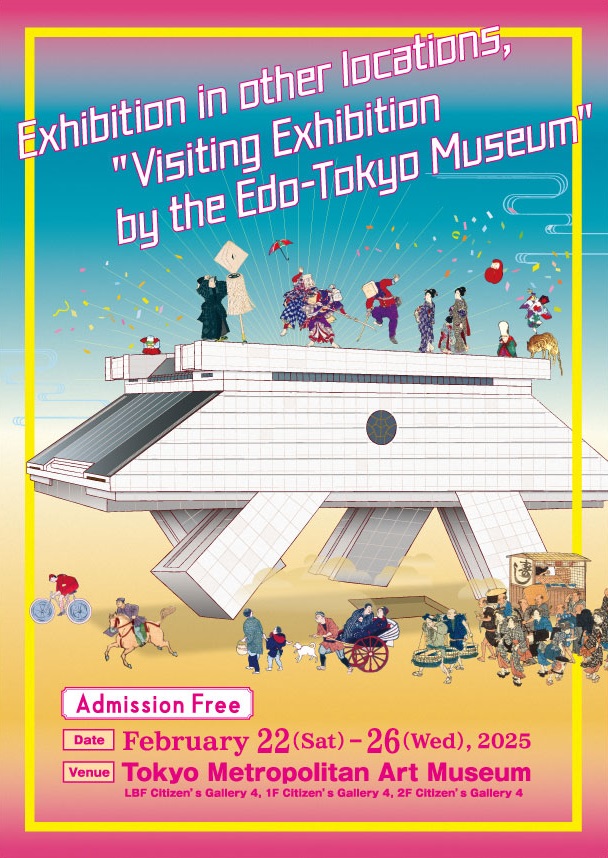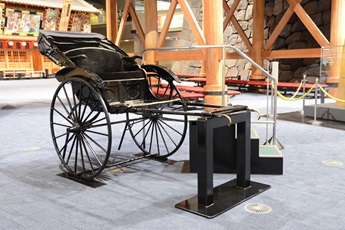2025.02.22(Sat)〜2025.02.26(Wed)


2025.02.22(Sat)〜2025.02.26(Wed)


The Edo-Tokyo Museum opened its doors on March 28, 1993, as a space to reflect on the history and culture of Edo-Tokyo and to envision the city and life in the future. Since then, we have had many visitors not only from Japan but also from all over the world.
Thirty years have passed, and we are now undergoing a major renovation, for which reason we will be closed until sometime in the spring of 2026 (planned). However, we are pleased to announce that, similarly to last year, we will be holding an exhibition to showcase some of our permanent collections at the Tokyo Metropolitan Art Museum in Ueno.
The exhibition will present a part of our permanent exhibitions across the LB and 1st floors. The exhibits include our popular interactive replicas such as the “Box for gold coins” and “Rickshaw,” and other related materials. There will also be a special exhibition on the 2nd floor, which introduces the history of Ueno, where the exhibition is held, through nishiki-e (colored woodblock prints) and postcards. Enjoy seeing the townscape of Ueno evolving over time.
We hope these exhibitions will provide an opportunity to experience the charm of the Edo-Tokyo Museum, as well as the history and culture of Edo-Tokyo, through a wide range of our collections.
| Date | February 22 (Sat) - 26(Wed), 2025 |
|---|---|
| Venue | Tokyo Metropolitan Art Museum LBF Citizen’s Gallery 4, 1F Citizen’s Gallery 4, 2F Citizen’s Gallery 4 |
| Access | 7 min walking from JR Ueno Station “Park Gate” 10 min walking from Ueno Station “Exit 7”, Tokyo Metro Ginza Line and Hibiya Line 10 min walking from Keisei Line Keisei Ueno Station *No parking area, so please refrain from coming by car. |
| Exhibition Hours | 9:30 – 17:30(Last admission 17:00) |
| Closed | None (Open every day during exhibition period) |
| Organized by | Tokyo Metropolitan Edo-Tokyo Museum operated by Tokyo Metropolitan Foundation for History and Culture |
| Admission | Free |
| Contact | 050-5541-8600(9:00 – 20:00) |
Exhibition Flyer
 |
 |
List of Works
The Edo-Tokyo Museum’s permanent exhibitions consist of 20 thematic sections and are largely divided into two zones: Edo and Tokyo. For this time, we have selected materials from three sections of Edo zone (Edo Castle and the District Zones, Life of the Townspeople, and Commerce of Edo) and two sections of Tokyo zone (Behind the Scenes of “Enlightenment”, and Tokyo and the Industrial Revolution). Visitors can enjoy the essence of our permanent exhibitions.

Old Views of Edo Castle: Ōtemon Gate/ Printed on Panel |

Famous Views of the Eastern Capital: Waiting for the Moon on the 26th Night at Takanawa/ Printed on Banner |

Mitsui Group Daiichi National Bank Building by Kaiumbashi Bridge in Tokyo/ Printed on Banner |

The Scenery of Nihonbashi Bridge, Tokyo/ Printed on Banner |
Many people may think of some interactive replicas when they hear the name of the Edo-Tokyo Museum. In this exhibition, we will showcase our popular interactive replicas such as Rickshaw, Box for gold coins, Tricycle, and other related materials.

Rickshaw (a man-pulled cart) / Replica |

Box for gold coins/ Replica |
The area around Ueno Park, a major landmark of Ueno, is also known as “Ueno Hill” because of its location on the edge of the Musashino Plateau. Back in the Edo period, Ueno Hill was a religious sanctuary of the Tokugawa Shogun family, including the vast grounds of Kan’ei-ji Temple as well as numerous sub-temples. Meanwhile, Ueno Yamashita and Shitaya Hirokōji (Ueno Hirokōji), which are areas located at the foot of the hill, prospered as part of the temple town of Kan’ei-ji Temple. In response to numerous major fires, firebreaks were established in both areas to prevent the spread of fire. This led to Shitaya Hirokōji becoming a residential area with townhouses, while Ueno Yamashita became one of Edo’s most famous amusement districts with numerous stores and show tents.
Later, following the destruction by fire of Kan’ei-ji Temple due to the Battle of Ueno (1868), Ueno was transformed into a space that symbolizes the Meiji government’s modernization policies. Ueno Park was created on the former site of Kan’ei-ji Temple. It served as the venue for various exhibitions and expositions such as the National Industrial Exhibitions, which showcased Japan’s industries and culture to the world. The construction of a railway and opening of Ueno Station led to Ueno becoming a major transport hub, and Ueno Yamashita and Shitaya Hirokōji became a leading downtown area bustling with people.
This exhibition introduces the history and townscape transformation of Ueno through nishiki-e (colored woodblock prints) and postcards. Enjoy seeing how Ueno has evolved over time.

Steam Train Leaving Ueno, Tokyo |

Directory of Famous Places in Edo Sugoroku Board |

Bronze Statue of Saigō Takamori at Sannōdai in Ueno |

Famous Landmarks of the Imperial Capital, View of Ueno Hirokōji and Shinobazu Pond |

One Hundred Famous Views of Edo: Hirokōji Avenue, Shitaya |
※Contents of workshops may be changed without notice.
Let’s explore the various musical instruments that accompany traditional performances such as Kabuki plays.
| Date | February 23 (Sun), 2025 ①11:00-12:00 AM ②2:00-3:00 PM |
|---|---|
| Venue | 1F Citizen’s Gallery 4 |
| Capacity | 20 people for each session |
| Admission | Free ※The tickets will be distributed 30 minutes before the start at 1F Citizen’s Gallery 4, located on the first floor. ※Adults will be required to accompany young participants. |
We introduce highlights of the Special Exhibition : The Transforming Townscape of Ueno.
Lectures are in Japanese only.
| Date | February 24 (Mon), 2025 ①14:00PM |
|---|---|
| Venue | 2F Citizen’s Gallery 4 |
| Admission | Free ※Please arrive at the entrance of Gallery No.4 before the event begins. |
